From mousy ‘Shy Di’ in puff-sleeved pastels to chic, sleek, internationally renowned fashion star, the life of the late Diana, Princess of Wales was an epic journey – sartorially, and in every sense. And the fact that Diana retains her style-muse status – two decades on from her shocking death – speaks volumes about the powerful impact she made. Her early unsophisticated look, previously dismissed in fashion circles as ‘Sloaney’ and uncool, has become the epitome of fashion in 2017.
Marking the 20-yearanniversary of her tragic death, Diana’s style evolution is explored in the exhibition Diana: Her Fashion Story at Kensington Palace. Although Diana has frequently been cast as a victim, what emerges from the exhibition is the sense that she was a strong-minded, independent woman, one who actively championed her chosen causes and personal goals. The collection of outfits on display explores Diana as an innovator in visual messaging, a disrupter of convention, and a pioneer in the way she turned her own narrative into her brand. After those early, guileless Lady Di days – including the famously revealing backlit photograph in a semi-transparent skirt – she learned the rules of public dressing and, significantly, learned how to bend and break those rules.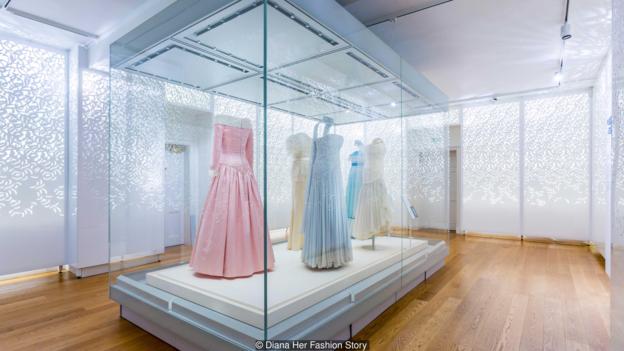
Diana’s fashion evolution is explored in an exhibition currently taking place at Kensington Palace (Credit: Diana Her Fashion Story)
The floral prints, pie-crust collars, high-waisted jeans and pussy-bow blouses that Diana sported in the early days of her public life are now everywhere in fashion. A recent collection for Asos was a direct homage, featuring pearl-trim shift dresses and Sloaney kilts; many designers, including the influential JW Anderson, have drawn on classic Di trademarks such as the currently ubiquitous voluminous, billowing sleeves.
She quietly signaled a departure from the famously buttoned-up, rigid royal codes
So why has the early-Di look struck such a chord now? “Fashion is cyclical, and so various trends will always make a re-appearance,” Eleri Lynn, curator of the exhibition, tells BBC Culture. “Diana, Princess of Wales’s power was that when she wore something, the look was so copied and so emulated that it became almost definitively hers, such was her cultural impact – the pink Emanuel ‘New Romantic’ style blouse she wore was immediately dubbed the ‘Lady Di Blouse’, and is still known that way.”
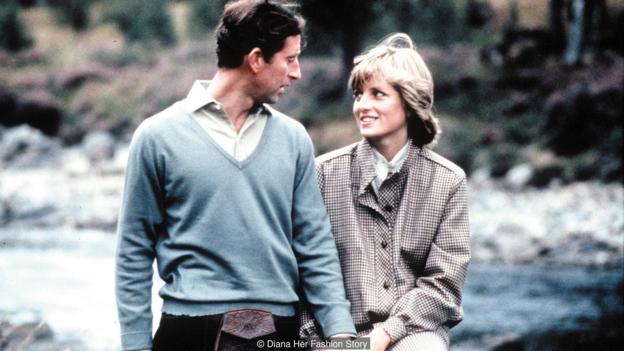
While her honeymoon tweeds adhered to the rules in terms of fabric, the jacket’s blouson shape referenced current trends (Credit: Diana Her Fashion Story)
Not that Diana was the first royal to set trends. As Lynn explains: “The Royal Family has a long tradition of being fashionable, dating back centuries probably, as high-society sought to emulate their style. Princess Margaret, for example, was regarded as highly fashionable and the press reported often on her wardrobe. I think the difference is that Lady Diana Spencer stepped on to the international stage at a time when the media itself was changing – with rolling news, tabloid journalism, and the dawn of the digital age – and so the effect of Diana’s wardrobe on wider public trends was much more immediate than ever before. She quickly learned how to use her image to communicate her messages and goals however, and to help her to do the job at hand.”
The exhibition explores this process. “It’s been fascinating to look at some of the risks Diana took with fashion,” says Lynn. “She learned the unwritten rules of royal dressing, and she liked to break them sometimes, even with tiny touches of something daring. She was the first female royal to wear trousers to an evening event. She liked to wear tuxedo-style outfits and she wore a lot of black – a colour usually only worn by the royal family for mourning.”
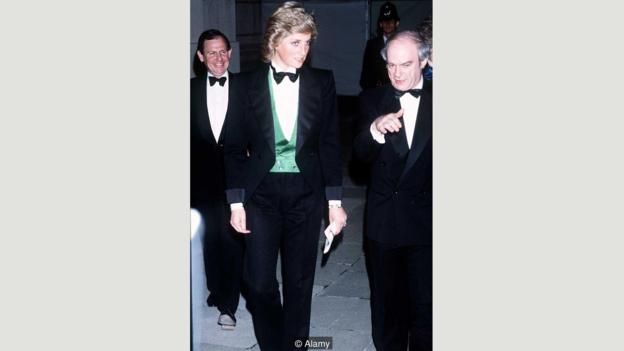
Diana gently challenged conventional royal dress codes by wearing a lot of black and tuxedo-style outfits (Credit: Alamy)
It was a subtle kind of subversion. A Bill Pashley tweed skirt suit worn for the official honeymoon photograph with Charles, Prince of Wales, at Balmoral adhered to the traditional royal country-dressing rules in the fabric, while also cleverly bending those rules in the voluminous shape of the jacket. The informal, on-trend blouson shape referenced a more current style and quietly signalled a departure from the famously buttoned-up, rigid royal codes.
“In the Tudor period the message was clearly to project status and majesty,” says Lynn. “The modern Royal Family project diplomatic messages with their clothes.” Diana knew what was required of her, and collaborated with designers “to communicate the regal, soft-power diplomacy that was part of her job.” Many of Diana’s dresses were created by Catherine Walker and Co, her most long-standing designer. Walker herself died in 2010, and the Chelsea atelier continues under her business partner and now widower, Cyrus Said, who tells BBC Culture: “We were guided by the origins of royal dressing. Queen Mary and Queen Alexandra and their era which exuded elegance and luxury.”
Breaking taboos
Tradition and history certainly mattered, but Diana and her collaborators continued to add twists and tweaks, promoting British fashion worldwide in the process. She dressed in an increasingly ‘glamazonian’ style as she entered the so-called ‘Dynasty Di’ phase of the mid-1980s, adopting more embellishments and strong-shouldered silhouettes. The green sequinned, wide-shouldered evening gown by Catherine Walker that she wore in 1986 is a standout example of, as Walker herself had put it, a “dignified showstopper”. Curator Lynn says: “She certainly enjoyed expressing her personality through her dress, and playfully added personal touches to her look that conveyed her own sense of fun – such as wearing mismatched accessories or bold statement pieces. The designer David Sassoon recalls that she often had a playful glint in her eye when trying clothes on, and remarking: ‘Oh, they’re going to love this!’”
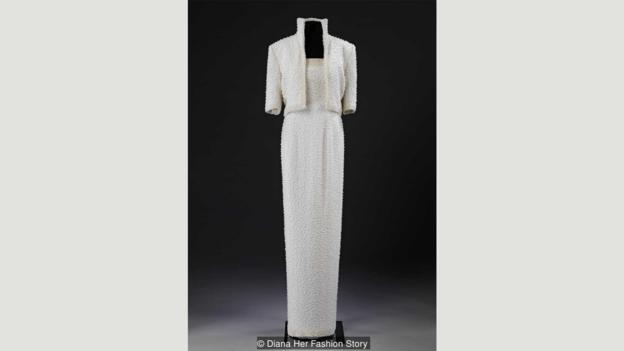
The ‘Elvis dress’ designed by Catherine Walker is one example of Diana’s glamorous and glitzy mid-80s style (Credit: Diana Her Fashion Story)
The so-called ‘Elvis dress’ that Diana wore in 1989 was even more daring and glitzy, and another Catherine Walker creation. A strapless white silk-crepe number teamed with a shimmering stand-up collared jacket, embroidered with luminous sequins and pearls, it was fabulously over the top. Cyrus Said says that the design process with Diana was always “an intimate collaboration. A beautiful dress is not per se a thing of beauty – it’s a combination of or a tension between the woman and the dress. The designer should be in the supporting role, giving her the tools she needs to get the job done. It’s about the union of the woman and the dress, which is how we operate.”
She said she wanted to be a work-horse, not a clothes-horse – Eleri Lynn
Diana’s mid-’80s look was glamorous, at times excessive – and completely of the moment. “The [Dynasty] look was very popular,” says curator Lynn, “It reflected the power dressing that was fashionable at the time, when women were seen to be stepping into the boardroom and using power suits to project authority. And you actually start to see her move away from the seasonal changes in fashion from this point onwards, to develop more of a timeless look. This is when she started to have confidence in her own sense of style, and in what suited her.” The sweeping Victor Edelstein midnight-blue velvet evening dress, worn at a state dinner at the White House in 1985 when the princess famously danced with Hollywood star John Travolta, was another key moment in Diana’s story. Images of the pair gliding gracefully around the dancefloor filled TV screens and newspapers across the globe. It was a bold – subtly maverick – message of glamour, confidence and independence.
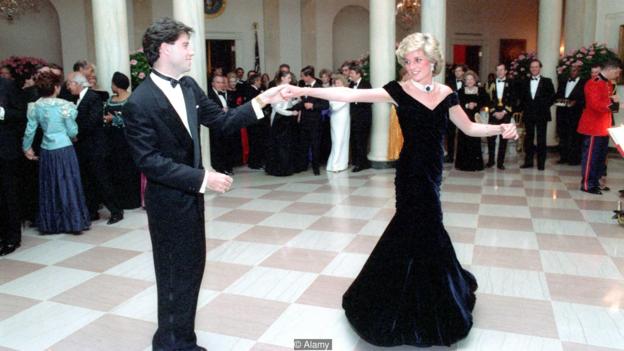
Dancing with John Travolta in 1985 in a sweeping Victor Edelstein velvet dress was a bold statement of glamour and independence (Credit: Alamy)
Following Diana’s separation from Prince Charles and having dropped the HRH in her title, she had more freedom to experiment with some non-British designers, for instance with the sleek, ice-blue beaded Versace gown that she wore for a Harper’s Bazaar cover shoot with photographer Patrick Demarchelier in 1991. She appeared in this phase of her life to come into her own, and seemed at her most slick, elegant and focussed. She forged her new public role, championing a number of charitable and humanitarian causes. “She said she wanted to be a work-horse, not a clothes-horse,” says Lynn, “and simplified her look in order to focus the press attention on her work not her wardrobe.” The shift dresses, simple skirt suits and the classic white shirt-and-chinos combination (which she wore for her landmine charity trips) conveyed a brisk professionalism. And in 1997 Diana donated 79 of her most lavish dresses for auction at Christie’s in New York, raising a hefty £3.4 million for cancer and HIV charities. As Said Cyrus puts it: “Her legacy was the way she used her position to help save lives.”

The classic white shirt-and-chinos combination that Diana wore for her landmines trips signalled professionalism (Credit: Alamy)
“She had a lasting impact on the way the public perceived those suffering from Aids and HIV,” Lynn says. “She hardly ever wore gloves, but on one famous occasion when she did, she very conspicuously removed them to hold hands with an Aids patient, breaking the taboo surrounding the disease. [She was] using dress to really hammer home her point. On official engagements, Diana thought really carefully about who she was meeting and how she would be perceived.
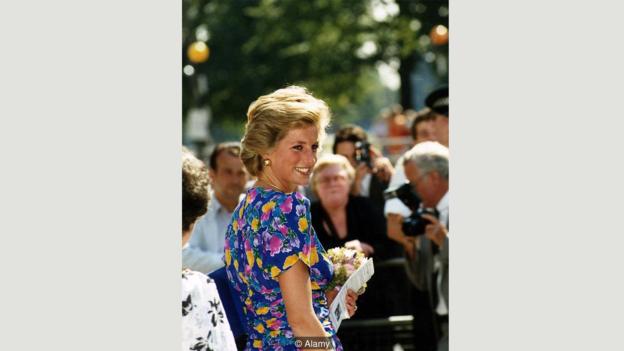
David Sassoon’s 1988 blue dress with printed flowers was named by the princess her ‘caring’ dress because children loved it (Credit: Alamy)
“She dressed to communicate approachability and warmth – to encourage informality – as she did by wearing cheerful, less formal clothing to children’s hospitals. David Sassoon’s 1988 blue dress with printed flowers was named by the princess her ‘caring’ dress because children loved it. David sketched it with a hat but she never ordered it as she said ‘you can’t cuddle a child in a hat’. Her legacy was in the humanitarian causes she championed and in the people whose lives she touched.” Undisputed fashion icon though she was, Diana is likely to be remembered for much more than her pie-crust collars or her shimmering gowns.